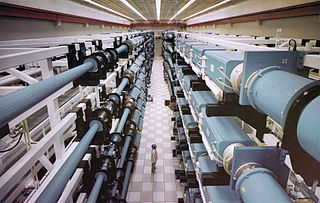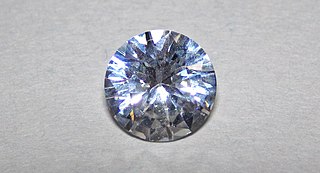Related Research Articles

A laser is a device that emits light through a process of optical amplification based on the stimulated emission of electromagnetic radiation. The word laser originated as an acronym for light amplification by stimulated emission of radiation. The first laser was built in 1960 by Theodore Maiman at Hughes Research Laboratories, based on theoretical work by Charles H. Townes and Arthur Leonard Schawlow and the optical amplifier patented by Gordon Gould.
Isotope separation is the process of concentrating specific isotopes of a chemical element by removing other isotopes. The use of the nuclides produced is varied. The largest variety is used in research. By tonnage, separating natural uranium into enriched uranium and depleted uranium is the largest application. In the following text, mainly uranium enrichment is considered. This process is crucial in the manufacture of uranium fuel for nuclear power plants and is also required for the creation of uranium-based nuclear weapons. Plutonium-based weapons use plutonium produced in a nuclear reactor, which must be operated in such a way as to produce plutonium already of suitable isotopic mix or grade.
Enriched uranium is a type of uranium in which the percent composition of uranium-235 has been increased through the process of isotope separation. Naturally occurring uranium is composed of three major isotopes: uranium-238, uranium-235, and uranium-234. 235U is the only nuclide existing in nature that is fissile with thermal neutrons.

A fusion rocket is a theoretical design for a rocket driven by fusion propulsion that could provide efficient and sustained acceleration in space without the need to carry a large fuel supply. The design requires fusion power technology beyond current capabilities, and much larger and more complex rockets.

Inertial confinement fusion (ICF) is a fusion energy process that initiates nuclear fusion reactions by compressing and heating targets filled with fuel. The targets are small pellets, typically containing deuterium (2H) and tritium (3H).

Nuclear pulse propulsion or external pulsed plasma propulsion is a hypothetical method of spacecraft propulsion that uses nuclear explosions for thrust. It originated as Project Orion with support from DARPA, after a suggestion by Stanislaw Ulam in 1947. Newer designs using inertial confinement fusion have been the baseline for most later designs, including Project Daedalus and Project Longshot.

A laser diode is a semiconductor device similar to a light-emitting diode in which a diode pumped directly with electrical current can create lasing conditions at the diode's junction.

The National Ignition Facility (NIF) is a laser-based inertial confinement fusion (ICF) research device, located at Lawrence Livermore National Laboratory in Livermore, California, United States. NIF's mission is to achieve fusion ignition with high energy gain. It achieved the first instance of scientific breakeven controlled fusion in an experiment on December 5, 2022, with an energy gain factor of 1.5. It supports nuclear weapon maintenance and design by studying the behavior of matter under the conditions found within nuclear explosions.

Aneutronic fusion is any form of fusion power in which very little of the energy released is carried by neutrons. While the lowest-threshold nuclear fusion reactions release up to 80% of their energy in the form of neutrons, aneutronic reactions release energy in the form of charged particles, typically protons or alpha particles. Successful aneutronic fusion would greatly reduce problems associated with neutron radiation such as damaging ionizing radiation, neutron activation, reactor maintenance, and requirements for biological shielding, remote handling and safety.

Yttrium aluminium garnet (YAG, Y3Al5O12) is a synthetic crystalline material of the garnet group. It is a cubic yttrium aluminium oxide phase, with other examples being YAlO3 (YAP) in a hexagonal or an orthorhombic, perovskite-like form, and the monoclinic Y4Al2O9 (YAM).

The Shiva laser was a powerful 20-beam infrared neodymium glass laser built at Lawrence Livermore National Laboratory in 1977 for the study of inertial confinement fusion (ICF) and long-scale-length laser-plasma interactions. Presumably, the device was named after the multi-armed form of the Hindu god Shiva, due to the laser's multi-beamed structure. Shiva was instrumental in demonstrating a particular problem in compressing targets with lasers, leading to a major new device being constructed to address these problems, the Nova laser.

Laser pumping is the act of energy transfer from an external source into the gain medium of a laser. The energy is absorbed in the medium, producing excited states in its atoms. When for a period of time the number of particles in one excited state exceeds the number of particles in the ground state or a less-excited state, population inversion is achieved. In this condition, the mechanism of stimulated emission can take place and the medium can act as a laser or an optical amplifier. The pump power must be higher than the lasing threshold of the laser.

A ruby laser is a solid-state laser that uses a synthetic ruby crystal as its gain medium. The first working laser was a ruby laser made by Theodore H. "Ted" Maiman at Hughes Research Laboratories on May 16, 1960.

Project Excalibur was a Lawrence Livermore National Laboratory (LLNL) Cold War–era research program to develop an X-ray laser system as a ballistic missile defense (BMD) for the United States. The concept involved packing large numbers of expendable X-ray lasers around a nuclear device, which would orbit in space. During an attack, the device would be detonated, with the X-rays released focused by each laser to destroy multiple incoming target missiles. Because the system would be deployed above the Earth's atmosphere, the X-rays could reach missiles thousands of kilometers away, providing protection over a wide area.

Inertial Fusion Energy is a proposed approach to building a nuclear fusion power plant based on performing inertial confinement fusion at industrial scale. This approach to fusion power is still in a research phase. ICF first developed shortly after the development of the laser in 1960, but was a classified US research program during its earliest years. In 1972, John Nuckolls wrote a paper predicting that compressing a target could create conditions where fusion reactions are chained together, a process known as fusion ignition or a burning plasma. On August 8, 2021, the NIF at Livermore National Laboratory became the first ICF facility in the world to demonstrate this. This breakthrough drove the US Department of Energy to create an Inertial Fusion Energy program in 2022 with a budget of 3 million dollars in its first year.
An X-ray laser can be created by several methods either in hot, dense plasmas or as a free-electron laser in an accelerator. This article describes the x-ray lasers in plasmas, only.
The National Nuclear Security Administration (NNSA) is a United States federal agency responsible for safeguarding national security through the military application of nuclear science. NNSA maintains and enhances the safety, security, and effectiveness of the U.S. nuclear weapons stockpile; works to reduce the global danger from weapons of mass destruction; provides the United States Navy with safe and effective nuclear propulsion; and responds to nuclear and radiological emergencies in the United States and abroad.
Szymon Suckewer is a Polish-born American physicist, and professor emeritus at Princeton University. His primary fields of interest include X-ray lasers, and X-ray microscopy, particularly the generation of ultrashort laser pulses which are applied in plasma diagnostics.
The history of nuclear fusion began early in the 20th century as an inquiry into how stars powered themselves and expanded to incorporate a broad inquiry into the nature of matter and energy, as potential applications expanded to include warfare, energy production and rocket propulsion.
References
- ↑ Hecht, Jeff. “The History of the X-ray Laser”. Optics and Photonics News. Optical Society of America, 2013. http://www.osa-opn.org/home/articles/volume_19/issue_5/features/the_history_of_the_x-ray_laser/#.UX3l-spUK0h
- ↑ Rearden, Steven L. .Congress and SDO. May 21, 1997. http://www.dtic.mil/dtic/tr/fulltext/u2/a338619.pdf
- ↑ Boody, Frederick P. "200-MW 2.026-pm He/Ar/Xe Pump Laser for Space Propulsion". Ion Light Technologies. https://ieeexplore.ieee.org/stamp/stamp.jsp?tp=&arnumber=1312158
- ↑ Lipinski, R.J.; McArthur, D.A. "Applications for reactor-pumped lasers". Sandia National Labs. 1994 Oct. 01. http://www.osti.gov/energycitations/product.biblio.jsp?osti_id=10186309
- ↑ Thomsen, Dietrich E. (14 December 1985). "Strategic defense of X-ray initiative". The Free Library. (1985). Retrieved May 08, 2013 from http://www.thefreelibrary.com/Strategic+defense+of+X-ray+initiative.-a04060251